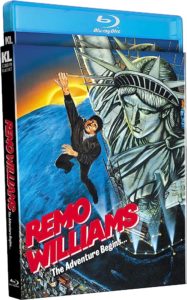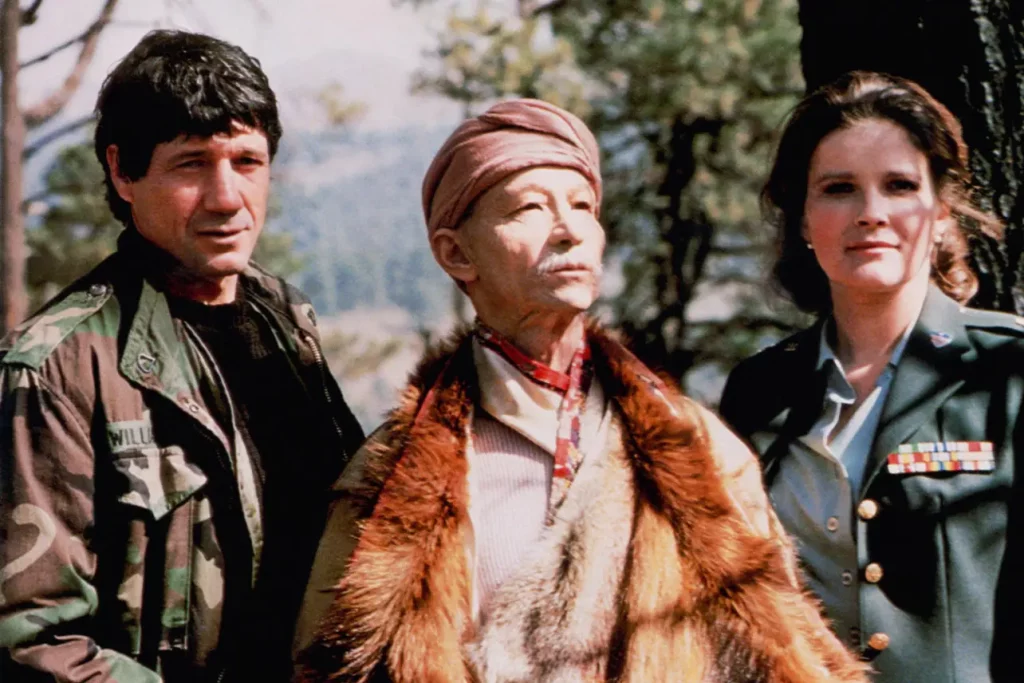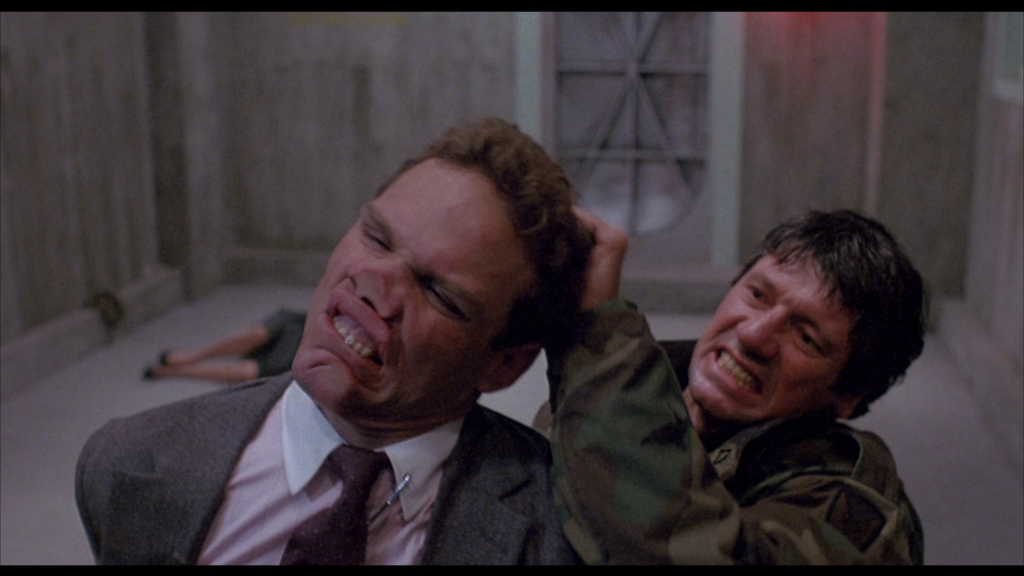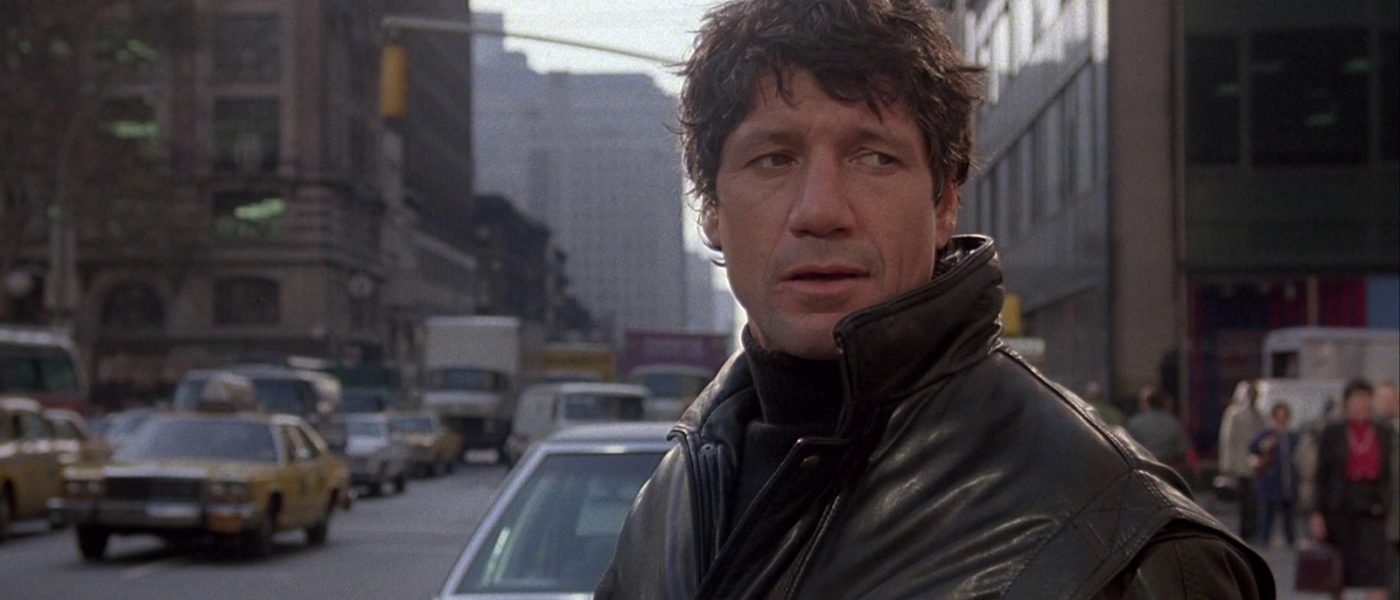Unarmed and Dangerous

Directed by Guy Hamilton
Starring Fred Ward, Joel Grey, Kate Mulgrew
Released October 11th, 1985
Rated PG-13
A mustachioed cop with a prominent nose (Fred Ward under prosthetics) has just broken up a ruckus on the banks of New York’s East River. Back in his patrol car, before he has time to eat a snack let alone call in the skirmish, a truck slams into his vehicle, pushing it, and him, into the river. There is a shot of the man (J.A. Preston) driving the assaulting truck’s cab, bespeckled and laughing, bathed in yellow flashing lights. I found this fleeting shot quite ominous when I first saw the film as a young child.
The next time we see the man driving the truck, he is attending the cop’s funeral. The next time we see the cop, he is waking up in a hospital bed, surprised to discover that his face has been surgically altered to look like Fred Ward. The man who rammed the cop into the river introduces himself as MacCleary, telling him that he is considered deceased and has been “recruited by an organization that doesn’t exist.” It was impactful for me as a kid to see J. A. Preston as MacCleary, a black man in a position of power. That wasn’t a typical thing to see in movies in the mid-eighties. Preston is great in the role, too.
MacCleary brings the cop to the small office of Harold Smith (Wilfred Brimley), who explains the unbelievable situation with laid-back, matter-of-fact confidence. Given a new face, new fingerprints, and a new name, “Remo Williams” is given a choice: act as this secret government agency’s enforcer or die. This begs the question: what happened to the previous enforcer? I’m guessing nothing good. “Remo” reluctantly goes along with this insanity, since he doesn’t really have a say in the matter. Smith and MacCleary reveal that Remo’s first directive is to train with a martial arts master.

And so, Remo is introduced to Chuin (Joel Grey), an elderly Korean man who becomes his reluctant sensei. Chuin admonishes Remo’s lack of fighting discipline, remarking that he “moves like a pregnant yak.” Grey brings a dancer’s physicality to the part of the wise-cracking, bullet-dodging, Yoda-like figure. I think Grey is excellent in the role, but I understand how modern audiences may not be able to accept his casting as a Korean mystic. To say that it is problematic is an understatement. It’s something that simply would not happen today. Yet at the time, makeup artist Carl Killman was nominated for an Academy Award for his work that transformed Grey into Chuin.
Remo is tasked with dismantling a corrupt Army weapons program, and eventually teams up with Major Rayner Fleming (Kate Mulgrew) to do so. We are introduced to Major Fleming as she is shutting down an Army colleague’s sexual harassment. Creepy men like this dude were often played for laughs in movies of the 1980s, and Major Fleming’s rebuff of her harassing co-worker serves as shorthand for the audience to regard her as a strong female character.
As previewed in the film’s promotional poster, there is an action sequence set at the Statue of Liberty. At the time of shooting, Lady Liberty was covered in scaffolding due to a massive rehabilitation project. This makes for a unique visual that would have made for a strong finale, but instead the thrilling scene is featured in the middle of the movie. A strange choice, especially since the film’s ending doesn’t feature a big set piece. Watching the visually boring finale set in a forest, one wonders if the producers ran out of money.

Director Guy Hamilton helmed notable James Bond films, including Goldfinger and Diamonds Are Forever, and screenwriter Christopher Wood wrote The Spy Who Loved Me and Moonraker, but this is not a spy flick in the vein of 007. Remo Williams is everything James Bond is not. He’s not suave, dashing, or a ladies’ man. He’s a blue-collar assassin in jeans, an American everyman with a particular set of skills. Ward plays Remo as a charming tough guy with an “aw shucks, what now?” attitude. We’re rooting for him from his first scene. In a just world, this movie would have made Fred Ward a huge star.
The film’s subtitle is “The Adventure Begins” and sure enough, when I saw this in theaters when I was seven, I thought it was going to be a huge hit that would spawn many sequels. Obviously, this didn’t happen, as the film failed to find an audience and we were robbed of hearing Craig Safran’s great main title theme accompany additional adventures. The character of Remo Williams continues to live on through a long-running series of books in the Destroyer series, originally created by Richard Sapir and Warren Murphy.
This is the kind of movie where cops say “Freeze!” and “Don’t get up. Don’t even breathe” after a scuffle, yet Remo Williams is a clever film with a screenplay that has fun with 1980s action movie tropes. Having seen the film once theatrically in 1985 and then many times thereafter when it was broadcast on television in the eighties, I was used to viewing a washed out, grainy, commercial-interrupted presentation. This Kino Lorber Blu-ray release is a godsend. I can’t get over how good the transfer looks. Right away you’ll notice how the colors on screen pop, courtesy cinematographer Andrew Laszlo. I doubt the film has ever looked or sounded better than it does in this edition.
The disc’s special features include the theatrical trailer, a radio spot, and many featurettes focusing on a myriad of production elements, from writing the script to composing the score. Also featured is an audio commentary by producers Larry Spiegel and Judy Goldstein that was recorded in 2014 for an earlier home video release. A few highlights from their enjoyable commentary include when Spiegel declares that the film’s budget of fifteen million dollars was the biggest ever given to an Orion production, and when Goldstein excitedly points out an appearance in the film from none other than Reginald VelJohnson.


